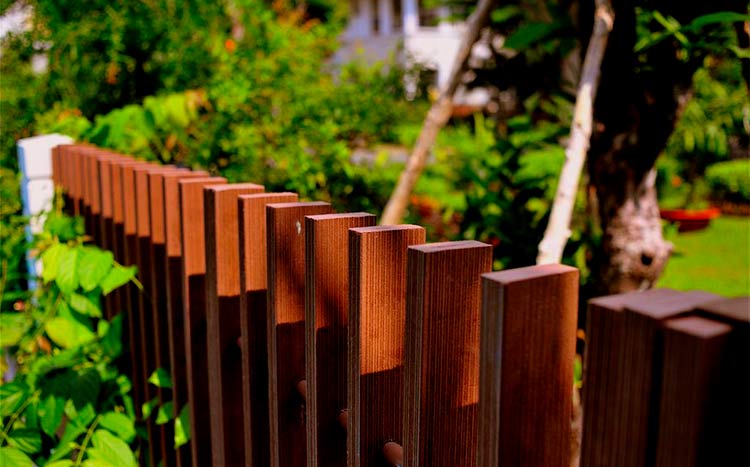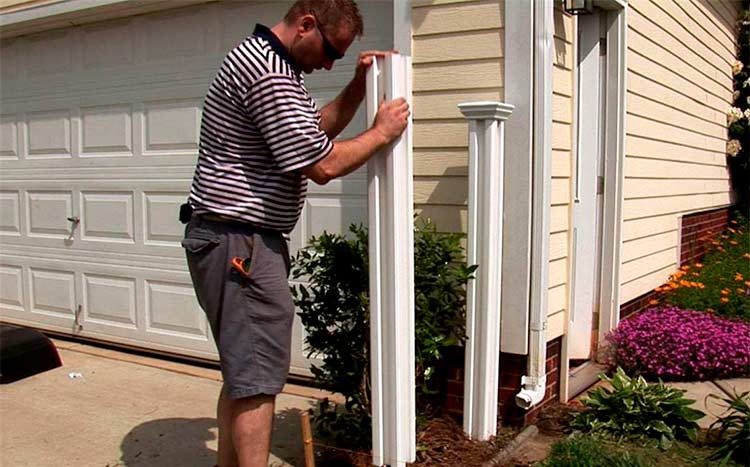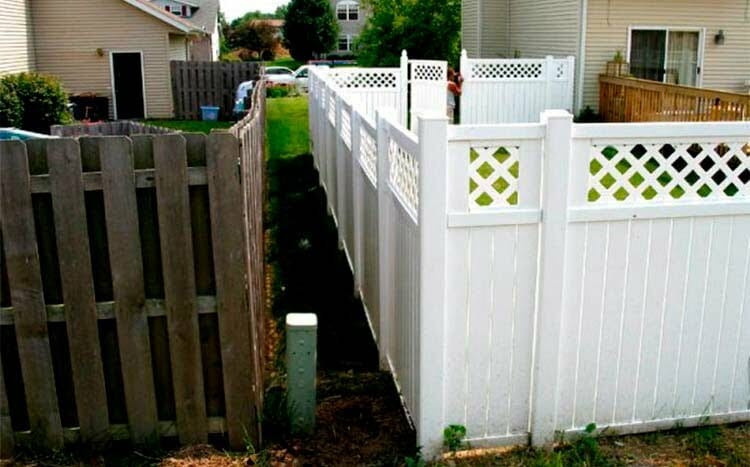Within the realm of fencing, Wood and Vinyl often emerge as leading options. Wood is favored by many for its rich historical background and enduring use in constructing fences. Conversely, Vinyl, a comparatively recent addition to the market, has seen a surge in popularity due to advancements in technology.
Vinyl is thus considered to be a better fencing material than wood due to its ability to last for long periods of time with little to no maintenance. It is also completely resistant to wood-specific challenges which include termites, fungi, fire and rot.
The only drawback which may be experienced when looking to fence with vinyl is its financial expense which is relatively higher than that of wood.

Cost of wood and vinyl
| Material | Low | High |
|---|---|---|
| Vinyl | $10 per linear foot | $60 per linear foot |
| Wood | $1-$5 per linear foot | $45 per linear foot |
Durability of vinyl and wood fences
Vinyl is generally known to outlast wood even though it costs about $5 more per linear foot when compared to its wooden counterpart.
This is because it is resistant to threats such as weather, insects, and rot which normally affect wooden fencing. It also does not become bent in appearance or pale in color as long as it is periodically cleaned as needed.
Wood fencing on the other hand is estimated to require complete replacement after 1-2 decades. Maintenance in terms of cleaning, treating, staining, and sealing is actually extremely essential for it to last that long.
It is also prone to warping and decaying as a result of weather, insects, mildew, and moisture.
Pros and cons of using Vinyl
Pros
Little to no Maintenance
Vinyl fencing is generally considered maintenance-free since it does not require activities such as painting, staining and sealing to keep it in check. It only requires periodical cleaning so as to keep it free from mold and mildew stains.
Natural Appearance
The artificial PVC make up of vinyl does not mean that it cannot look like traditional wood in appearance. This is because high-quality vinyl fences such as wood-grain are normally designed using traditional shades of color which resemble natural wood.
Long-Lasting
The durability of vinyl when it comes to fencing is unparalleled. This is because vinyl fences are usually able to stand strong in the face of rot, fungal growth and blisters which are known to cause damage to wooden fences.
Their artificial nature also makes them resistant to any cracking or splitting that may be as a result of weather or old age. Vinyl fencing is also fire, pest and insect resistant due to its inorganic and non-biodegradable features.
Easy to Install
Once the posts have been set, vinyl fencing is relatively easy to install. Although each panel is installed individually, the snapping together of subsequent pieces makes the process rather simple. If everything goes well, tools are usually not required.
Cons
Frequent Expansion and Contraction
Vinyl fencing is usually known to expand and contract as a result of temperature changes in the environment. It thus becomes more fragile when this process is repeated over time. Little or no space between vinyl panels also makes them susceptible to wind damage.
Large Upfront Investment
Vinyl fences generally cost between 2-3 times more than their wooden counterparts in terms of their initial price. They however prove to be cheaper in the long term since they do not require the maintenance investment that wooden fences do to stay in check.
Mold Staining
Vinyl fencing is susceptible to mold and mildew staining especially in cases where it is not periodically cleaned.
Pros and cons of using Wood
Pros
Low Initial Cost
The cost of wood fencing is generally known to be cheaper than vinyl in the short term. This is mostly because wood is a naturally available material as opposed to vinyl which must be industrially manufactured.
Flexibility
Wooden fencing is generally known to be more flexible when compared to vinyl due to its adjustable nature. In other words, the lengths of wooden fences can be changed to fit the owner’s preferences after they have been ordered which is not the case for vinyl.
They are also relatively easy to install and remove since manufacturers provide pre-assembled pieces of fencing.
Visual Appeal
Wooden fences still take the lead as far as visual appearance is concerned despite the mimicking effect of high-quality vinyl fences. They are thus preferred due to their rather traditional look which enables them to effortlessly blend into the environment.
Biodegradable
Wood is certainly the greenest option as far as fencing is concerned. This is because of its organic features which make it completely biodegradable, recyclable, and renewable.
Cons
Expensive in the Long Term
Wooden fencing is generally considered to be more expensive in the long term since it requires periodic maintenance. This maintenance normally comes in terms of painting, staining and sealing.
It is also not as durable as vinyl fencing which means that it may require a complete replacement after 10 years or so thus adding to its expense.
High Number of Vulnerabilities
Wood is generally affected by a wide range of factors which include fungi, rot, weather, pests and insects. It is such factors that make it loose visual appeal and structural credibility over time. This is normally manifested in terms of fading, cracking and warping.
Wooden fences are also known to be quite vulnerable to damage by fire since they are considered to be natural fuels.
Maintenance of vinyl and wood fence
Vinyl fencing is generally considered to be better than wood when it comes to maintenance. This is because it does not require procedures such as sealing, painting and staining which are normally applied on wood.
It however still requires periodic cleaning in the form of rinsing, soft-brush scrubbing and detergent washing if it is to maintain its charming appearance. Pressure washing can also be used in cases where the fence is extremely stained with dirt and mold.
Wood on the other hand generally requires a little more maintenance effort since it is highly susceptible to mildew, rot and insect damage. Staining is known to combat rot as long as it is done on a clean and dry wooden fence.
Painting is a cheaper option to staining because paint is prone to periodic cracking and peeling. It is thus advisable to apply it on a sanded and smoothened wooden fence for a greater long-lasting effect.
Both painting and staining can be complemented by sealing. Sealing is known to protect wood against rainy and moist weather conditions which facilitate mold growth and rotting.
Installation time
Wooden fences normally take an average of 3 days to put up for perimeters of between 100 and 200 feet. This time is usually inclusive of pre-installation preparation and post-installation clean up. It can however vary depending on weather and structural adjustments.
Vinyl fences on the other hand take an average of two days to install for 150-200 feet long perimeters. This is because they normally come in panels of fixed lengths that do not require adjusting. They can however also take longer to install in adverse weather conditions.

Effects on home value
Both wooden and vinyl fences can increase the value of a home. This is because they are able to provide an aesthetic appeal that can easily attract buyers. They can even give as much as 50% return on investment upon the sale of a house.
A new owner who decides to put up a new fence can also recoup up to half of the initial cost of the wood and vinyl upon resale.
There are however cases in which other real estate factors such as unique client preferences and curb appeal override the covering offered by both vinyl and wooden fences. In such situations, these fences usually have little to impact on the value of a home.
Repair
Repairing a wooden fence normally involves replacing rotten pieces and posts as well as broken rails. Wood is generally known to be heavier than vinyl and thus requires more effort when it comes repairing.
Vinyl repair may however take more time and resources since it demands the replacement of an entire panel when a single piece breaks. This is unlike wood repair which only factors in the replacement of the broken piece or post.
Engaging professionals is thus encouraged in both when looking to achieve optimum vinyl or wood fencing.
Home Garden Guides is a great tool that quickly matches you with the best fencing specialists in your locality. You can get three estimates from local fencing professionals in a matter of two minutes. Kindly follow the steps below to enjoy this great service:
- Scroll to the top of the page and enter your zip code
- Answer questions about your drywall job
- Your fencing details are forwarded to three local experts who will send you a price estimate for your job with some friendly advice.
Choosing between Vinyl and wood fences
When looking to get a beautiful and durable fence that does not require a lot of maintenance, vinyl is definitely the way to go. It may be more expensive initially but that cost will most certainly be justified in the future.
FAQ's
Does a vinyl fence increase home value?
Yes, it does, but not all of the time. A new vinyl fence has the capacity to enhance a home’s visual appeal which will inadvertently attract more buyers. This increase in traffic is most likely to increase the price of the home in question.
There are however cases in which a newly installed vinyl fence does not provide the expected return on investment. In such situations, other real estate factors such as comparability and buyer preferences usually edge out the fence in terms of weight.
Do vinyl fences break easily?
Vinyl fences generally do not break easily unless subjected to head-on collisions with hard objects such as stones and metals.
Which is harder to maintain, vinyl or wood?
Wood is definitely harder to maintain when compared to vinyl. This is because of how vulnerable it is to factors such as weather, mold, rot and insects. This vulnerability means that it must be subjected to periodic staining, painting and sealing so that it stays in shape.
Vinyl on the other hand only requires regular cleaning with water and detergent in order to maintain its visual appearance.







